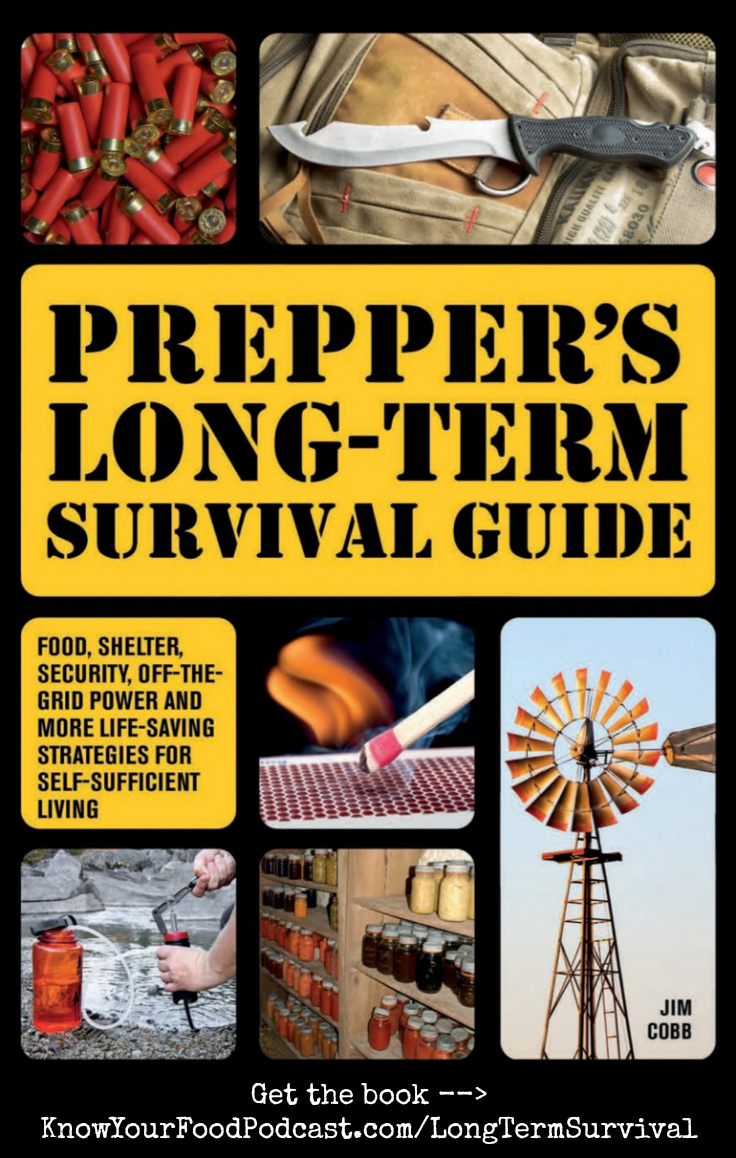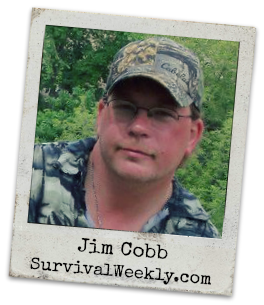Beyond the first 72 hours of a crisis or disaster, what will you do? The new book Prepper’s Long Term Survival Guide teaches you how to survive when nothing returns to normal for weeks, months, or even years. Today on the podcast, Jim Cobb from Survival Weekly joins me to talk about his new book and much more!
Get to know Jim through the links and information below, and of course through this podcast. Plus… the tip of the week!
Podcast: Play in new window | Download
Subscribe: RSS
Won’t play for you? Try here. Mobile or desktop users, you can hear my podcast with Stitcher, on-demand and on-the-go. (What’s Stitcher?) You can also get it on iTunes or subscribe in the Podcasts app.
Tip of the Week: Eggs Stuck on Cast Iron Pan
Naomi from Almost Bananas (lovely blog!) wrote in with a great tip!
“I don’t know if this tip is common knowledge, but when I figured it out I found it helpful. I like to use a cast iron pan (skillet) but occasionally get eggs stuck on them — you know that white film that is just glued on. Instead of using water and scrubbing (and ruining your seasoned surface), just put the dirty pan back on the heat. The egg scum will crisp up and practically flake off by itself.”
Fantastic tip, Naomi — thanks so much and you’re totally right!
Listener Question
Today’s question comes from Jamie:
“Hi Wardee,
First, thank you for generously sharing your wealth of knowledge with us. Our whole food transformation started to overwhelm me until I met you. Thank you for all you do to educate us!
We started brewing our own kombucha a few weeks ago, and we have had great success. We have even shared our new scobys with many of our friends. We are learning, however, that our family of five goes through kombucha way more quickly than we anticipated. A gallon every 7-10 days isn’t enough for us. I have come across some sources who claim to “continuously brew” kombucha in large glass containers, fermenting gallons at a time and adding tea as needed. Do you have thoughts about this? What are your kombucha brewing routines?
Thanks for all you do…
Blessings,
Jamie”
The podcast contains my answer. Also check out my Kombucha recipe in the archives, or my Lacto-Fermentation eCourse or eBook, both of which contain updated info, second fermentation instructions, bottling instructions, and other fermented beverage recipes. Additionally, here’s a great article at Cultures for Health describing the continuous brew process.
About Jim Cobb
“Jim has been a student of survivalism and emergency preparedness for almost thirty years. As a young child, he drove his parents nuts with stockpiling supplies in the basement every time he heard there was a tornado watch in his area. Of course, being a child, those supplies consisted of his teddy bear, a few blankets and pillows, and random canned goods he grabbed from the kitchen cabinets. Later, he was the first (and likely only) child in his fifth grade class to have bought his very own copy of Life After Doomsday by Bruce Clayton.
Today, he is a freelance writer whose work has been published in national magazines such as Boy’s Life and Complete Survivalist Magazine. He is a voracious reader with a keen interest in all stories with post-apocalyptic settings. He maintains the Library at the End of the World blog and is also the Content Director for SurvivalWeekly.com. He currently resides in a fortified bunker in the upper Midwest, accompanied by his lovely wife and their three adolescent Weapons of Mass Destruction.”
Click here for more info about Jim Cobb and Survival Weekly.
Podcast: Play in new window | Download
Subscribe: RSS
Links Mentioned
- Survival Weekly
- Survival Weekly on Facebook
- The Living Off the Land Fallacy blog post
- Lone Wolf Syndrome blog post
- Review: Condor Bush Knife
- (new book) Prepper’s Long-Term Survival Guide: Food, Shelter, Security, Off-the-Grid Power and More Life-Saving Strategies for Self-Sufficient Living by Jim Cobb
- (book) The Prepper’s Complete Book of Disaster Readiness: Life-Saving Skills, Supplies, Tactic, and Plans by Jim Cobb
- (book) Prepper’s Home Defense: Security Strategies to Protect Your Family by Any Means Necessary by Jim Cobb
- Disaster Prep Consultants
iTunes
I’m so grateful when you visit my show on iTunes and leave a rating and/or review! KnowYourFoodPodcast.com/iTunes This helps me make my podcast better and also helps others find it. Thank you! For past or current episodes, check out the Know Your Food with Wardee podcast archives.
Anything to Add?
I would love to hear from you! Do you have questions for Jim or comments about anything shared in this episode? Like this podcast? Please help me reach others by using the share buttons at the top of this post. Thanks!
We only recommend products and services we wholeheartedly endorse. This post may contain special links through which we earn a small commission if you make a purchase (though your price is the same).





Hi Wardee,
I have a continous brew kombucha system and I’m very low carb, so I set this up very carefully. I am fortunate that my husband is a wine maker by profession, so he helped me by testing residual sugars. The kombucha directly from the primary fermentation was too high in sugar for me. It came in at 4.6 grams per 100 ml, which comes out to about 11 grams of sugar per 8 oz of kombucha.
However, if I do a secondary fermentation, using dried cherries (12 per 16 oz) in 16 oz bottles for 3 to 5 days, the residual sugar comes in at 0.5 g per 100 ml, so that’s only around 1 gram of sugar per 8 oz.
This winter I’ve had a seedling heat mat under my continuous brewer. On Wednesday and Saturdays I draw off two 16 oz bottles of kombucha from the spigot at the bottom and replace it with new sweet tea on the top. I add the dried cherries to each bottle and put them out on the heat mat until the next bottling day, and then they go in the fridge. You can play around with the amounts–I’m the only one who drinks kombucha in my house, and I drink about 8 oz per day.
I use a 1.5 gallon brewing jar, so I’m only drawing off about 20 to 30% of the total. The fermented tea left in the brewer dilutes the new tea a lot–that’s part of the beauty of a continuous brewer–you are leaving a lot of already fermented tea in the brewer and using time as well–that way the sugar content of your draw will not be quite so high. You have to play around with it and test it until you find the right amounts and intervals to draw each time. You can also manipulate the temperature with a heat mat or a cool area, to determine how frequently your need to draw from it and the degree of fermentation.
I’m interested to see how it changes in the summer. We have no air conditioning, so we have days at a time when it can be quite hot in our house, though most of the time, even during the summer, it’s cool and pleasant in my kitchen. I know the temperature makes a huge difference with how fast my dairy kefir ferments, so I may end up drawing more frequently or have a “dryer” kombucha brew over the summer.
There are some real advantages to a continous brewer besides the convenience of only having one jar. Since I’m not touching and moving the SCOBY, there’s less chance of contamination. The ecosystem in the jar helps ensure that the beneficial microbes are predominant. And I don’t have to constantly clean anything but the bottles, and those go in the dishwasher (hooray!). I make up a big jar of tea concentrate and store it in the fridge, then I mix 6 oz of concentrate with 26 oz of water on “feeding day” to replace the two 16 oz bottles I draw off. I only have to make up tea concentrate about once a month, and I don’t have to wait for the tea to cool before I can use it–it’s cold arleady.
It takes a little bit of time and testing to work out how to make a continuous brewer work for your own needs, but I’m thrilled with mine.